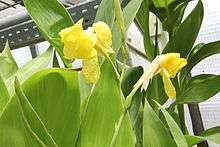Canna flaccida
Canna flaccida is a species of the Canna genus, a member of the family Cannaceae. The species is indigenous to the wetlands of the south-central and south-eastern United States from Texas to South Carolina. It is also reportedly naturalized in India, the Philippines, Mexico, Panama, Cuba, the Dominican Republic, Peru and southern Brazil.[2]
| Bandana-of-the-everglades | |
|---|---|
 | |
| Canna flaccida, only yellow, lightly perfumed canna. | |
| Scientific classification | |
| Kingdom: | Plantae |
| Clade: | Tracheophytes |
| Clade: | Angiosperms |
| Clade: | Monocots |
| Clade: | Commelinids |
| Order: | Zingiberales |
| Family: | Cannaceae |
| Genus: | Canna |
| Species: | C. flaccida |
| Binomial name | |
| Canna flaccida | |
| Synonyms[1] | |
| |
Canna flaccidawas a parent to many of the early-hybridised cannas originally known as orchid flowered cannas, but now correctly named as Italian Group cannas. It grows well as a water canna. Originally described by the early American explorer, William Bartram, when he found these plants blooming near the rivers of coastal Georgia. The seed floats down the rivers and becomes easily established on shorelines. Introduced to England in 1788.[3]
Canna flaccidais a perennial growing to 1.5m. It is hardy to zone 10 and is frost tender. In the north latitudes it is in flower from August to October, and the seeds ripen in October. The flowers are hermaphrodite.[4]
Taxonomy
In the last three decades of the 20th century, Canna species have been categorised by two different taxonomists, Paulus Johannes Maria Maas from the Netherlands and Nobuyuki Tanaka from Japan. In this case both agree that C. flaccida is a distinct species, and the DNA work by Prince and Kress at the Smithsonian Institution confirms its uniqueness.[5][6]
Description
Canna flaccida is aquatic species, with narrow, blue-green (glaucous) leaves, very pretty, large, lightly perfumed, canary yellow flowers growing in clusters at the tops of long stalks. The lip of the flower is wavy. Flowers emerge in the evening and wither in the heat of the following day, the only member of the genus that behaves in this manner, all others open early in the morning and are strong enough to survive at least one day. It grows as a marginal plant in up to about 15 cm of still or slow-moving water.[7]
References
- Kew World Checklist
- Kew World Checklist of Selected Plant Families, Canna flaccida
- Johnson's Gardeners Dictionary, 1856
- Cooke, Ian, 2001. The Gardener's Guide to Growing cannas, Timber Press. ISBN 0-88192-513-6
- Tanaka, N. 2001. Taxonomic revision of the family Cannaceae in the New World and Asia. Makinoa ser. 2, 1:34–43.
- "PRINCE, LINDA M.* and W. JOHN KRESS. Smithsonian Institution, NMNH - Botany, MRC-166, Washington, DC 20560-0166. - Species boundaries in Canna (Cannaceae): evidence from nuclear ITS DNA sequence data". Archived from the original on 2007-03-12. Retrieved 2006-09-19.
- Flora of North America v 22, Canna flaccida